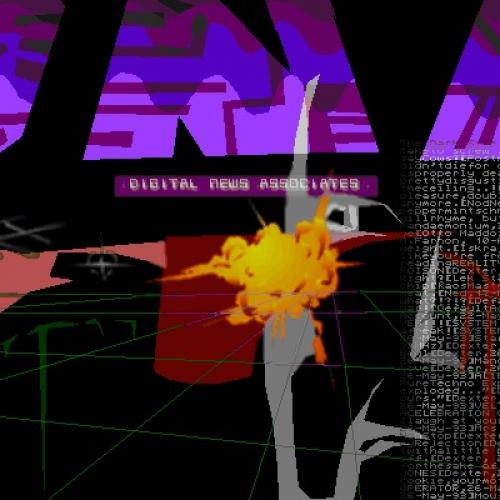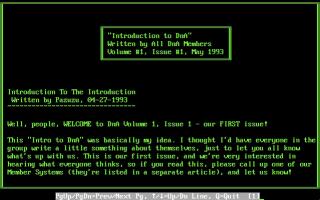DnA 3-11: Los Angeles: Holocaust 1993

Written: 4/09/92
By: Arclight
Los Angeles/Holocaust '93
Present and unnoticed by the jovial dinnertime Los Angeles crowds gathered below, it wisped by as a gnat does above a field. The Friday evening scene--the couples strolling along the Boulevard the queues of anxious people waiting outside the choicest restaurants, and the occasional passerby out for a casual walk in the lively, subtly expressive evening atmosphere--the scene that had taken place there on so many Friday nights before and, presumably, would continue to be acted out there for an eternity to come--was so far removed from what was about to take place that one scarcely could have guessed that this picture belonged to the same Los Angeles of just a short while later. The object slowly grew closer, closer yet. It is doubtful, also that anyone noticed the small, dark object falling from the Cessna 210 Twin Engine wafting by at extreme altitude. The Cessna, still visible, could have been seen making a high G-force turn and bank, departing with greater expedience than it had arrived with. Some seconds later, the intermingling sights and sound of the street melted into a single blinding, penetrating, searing pulse of light and heat, followed shortly by a mind pulverizing shockwave of shear force and brutality, reducing the pleasant Los Angeles of a thousand Friday evenings to ashes and blistering, boiling asphalt. There remained shadows, lingering long after their owners had deserted them, still clinging to the sidewalks where they had been forever fixed by the force of the atom. The colorful Boulevard had become an ash strewn inferno:the instant crematory for those who had not even had the chance to scream. As one travelled further from the Downtown, the level of carnage gradually decreased; some areas appeared nearly untouched, save for their lack of occupants, most of whom had attempted to flee the city along the decimated highways. In the streets, there could be seen packs of dogs feasting on what remained of the slaughter-their masters having long since departed them. The living, bustling, metropolis had been silenced. The heart had ceased to beat and the blood had all run out along those highways littered with the dead and the dying. The city had ceased to be.
This holocaust was not, however, the result of some world leader's over-eagerness to push the button, or some accidental initiation of Armageddon due to human error. Quite to the contrary, it was the result of a carefully planned and executed action carried out by a group of people intent on showing the world a lesson about the dangers of stockpiling nuclear weapons. The damage done by the single Uranium fission bomb was comparatively minor when compared to the existing potential for global catastrophe. Thus, the action of these individuals was carried out in an effort to avoid a future calamity rather than out of antisocial prejudice.
In the Spring of 1993, the individuals ultimately responsible for the bombing began to meet clandestinely to discuss what it would take to convince humanity to give up the vast stockpiling of nuclear weapons. All agreed that it would take drastic measures to convince people of the danger present in the system, and to force them to listen to reason, rather than the assurances of government leaders. It was during this period that they began to go over possible options.
Various ideas were presented. Most ended up being rejected on the basis of being too costly, impractical, or not yielding satisfactory results. The option of staging a nuclear accident at a Plutonium production facility, such as Savannah River or Hanford, Washington was ruled out as being too difficult and not leaving people sufficiently disgusted with the authorities. Even if a sabotage effort could carried out effectively enough to cause a massive fission product release into the atmosphere, would this really shock the public? The D.O.D. could gloss over it and make it look like a minor event. Also, reactors and their associated equipment are housed behind several layers of shields and barriers. Complete penetration would be difficult or perhaps impossible under normal circumstances. Hijacking a truck carrying spent fuel rods from a commercial reactor would demonstrate nothing and would, likewise, be risky. But, to build a simple fission bomb would be relatively simple. The Uranium type can assembled with relative ease, as the critical elements can be brought together into a supercritical assembly by simply pushing one element, a subcritical mass, into a hole bored into another, also a subcritical mass.
When a large enough amount of a readily fissile material, such as Uranium in its (235) isotope, or plutonium in its natural state, a release of a Neutron which hits another atom of the material will cause Fission, or splitting apart of the nucleus, releasing more Neutrons which collide with more nuclei which continue to propagate the reaction until the material is totally consumed. When the number of Neutrons being released exceeds the number of Neutrons being absorbed by inert molecules, or otherwise lost, the assembly is said to be Supercritical, that is, it is releasing more Neutrons than are needed to sustain the reaction. A critical mass is the mass of fissile (splittable) material required to achieve this state. In a Plutonium bomb, the two halves of the critical mass are usually brought together as hemispheres under an implosion force with explosives.More force is required to bring the halves together than is required to assemble a Uranium bomb. As mentioned, the parts are machined so that one fits inside another and one is pushed into the other with a small explosive charge. This type is much simpler to construct. The only difficulties in building this device are in obtaining Uranium that contains at least 25% of the (235) isotope, which is normally found in a 2% concentration mixed with its more common isotope (238). As the two are chemically identical, they can only be separated through slight differences in mass. In the U.S., this has always been done through gasseous diffusion, where the Uranium is made into Uranium hexaFluoride and then pushed through porous tubes. The lighter (235) diffuses faster and is thus collected. For a small scale operation, it would be much easier to steal it, ready made, than to separate it. Once obtained, the Uranium can be cast into the desired shape ina vacuum furnace and then machined to final size. A quantity of 10 pounds would be sufficient to produce a working bomb.
The necessary Uranium was ultimately obtained a terrorist raid on Lawrence Livermore Laboratories. Security is dependant on human factors and weak spots are always present. A minimum number of people were killed and the government chose to cover up the incident, not fully realizing what had been taken until the bomb was already assembled. Sensitive research data was extensively tampered with and served as a bluff to draw attention away from the bomb material.
The bomb casing was assembled from high quality pipe conduit and was fabricated at a well equipped machine shop that the group was able to use. The Uranium was cast in a vacuum furnace at a local university metallurgy lab and was machined under water cooling, to avoid fire. The conventional explosive used was a .50lb charge of RDX (Cyclonite) high explosive. Commercial No8 blasting caps were used, in a set of two to insure reliability. The fuze consisted of an analog altimeter connected as a switch. Two were used, again, for reliability. The fissile material weighed a total of 47lbs, 2.3oz. with the bomb weighing in at 335lbs, 8.2oz. The entire payload was fitted into the cabin of Cessna 210 light plane.
On April 14,1993, 5:02pm, the bomb was dropped over downtown Los Angeles. It exploded at an altitude of 8000 feet. The plane carrying the perpetrators landed safely some distance across the Mexican border. The perpetrators were captured by the Mexican Federal Police some months later and are still awaiting extradition to the United States.
By dropping the bomb, several thousand people were killed and countless were wounded. As people perhaps it was necessary to witness the horror of atomic warfare firsthand in order to avoid it. It is impossible to say whether it was the right decision for the betterment of mankind, but it reached everyone in a way that said "This problem can no longer be ignored!" Perhaps with that goal accomplished, humanity has been served by this.
The End ?





















